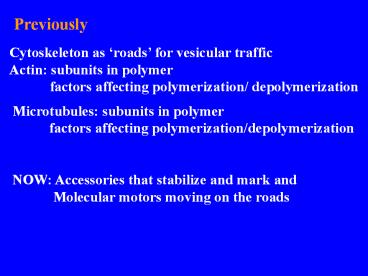Previously - PowerPoint PPT Presentation
1 / 12
Title:
Previously
Description:
Title: Barroso et al. and a role for TAP Author: Karen Bernd Last modified by: Karen Bernd Created Date: 10/31/2002 1:18:45 AM Document presentation format – PowerPoint PPT presentation
Number of Views:58
Avg rating:3.0/5.0
Title: Previously
1
Previously
Cytoskeleton as roads for vesicular
traffic Actin subunits in polymer factors
affecting polymerization/ depolymerization
Microtubules subunits in polymer factors
affecting polymerization/depolymerization NOW
Accessories that stabilize and mark and
Molecular motors moving on the roads
2
Associated proteins cellular
Roles of associated proteins
3
Localization of Accessories
MAP2
tau
4
Associated Proteins experimental uses
Markers Indicative of some roles
5
Some associated proteins move
Molecular Motors
Three major families Dyneins Myosins Kinesins
6
Similarities
General structure Globular head and helical
tail (head contacts cytoskeleton, tail with
cargo) Core domains contain nucleotide binding
sites (folding and functionnot a.a.
sequence) Mechanism Bind ATP Cycle of ATP
binding and hydrolysis involved in changing
association with cytoskeleton
7
Examples
CBI 16.8, 16.6 myosin 16.7 kinesin 16.5
movement along MT
8
Differences
Cytoskeletal element associated with Direction
of movement Where and how ATP hydrolysis is
used How movement is generated (lever arm,
loops) Processive vs non processive movement
9
Bipolar Research Directions?
Steps required for neurotransmitter
localization Possible directions? Directions to
discard? Steps for neurotransmitter
production Possible directions? Directions to
discard? Steps for neurotransmitter release/
re-uptake Possible directions? Directions to
discard?
10
Bipolar More Questions. Answers?
Reason for cyclic nature? Reason for variable
symptoms?
11
What do we know now?
- Complex genetic disorder
- More than one gene product,
- More than one combination of gene products,
- Environmental components (stress, food, light..)
- Variations/gradations depending on combo. Of
genes, mutations and environmental aspect
12
GSK 3?
- Lithium action and GSK 3??function-- connection?







![READ [PDF] Leonard Maltin's Movie Guide: The Modern Era, Previously Pu PowerPoint PPT Presentation](https://s3.amazonaws.com/images.powershow.com/10078099.th0.jpg?_=20240713096)























